
Freight transportation and logistics provider Saia (NASDAQ:SAIA) fell short of the market’s revenue expectations in Q1 CY2025 as sales rose 4.3% year on year to $787.6 million. Its GAAP profit of $1.86 per share was 32.6% below analysts’ consensus estimates.
Is now the time to buy Saia? Find out by accessing our full research report, it’s free.
Saia (SAIA) Q1 CY2025 Highlights:
- Revenue: $787.6 million vs analyst estimates of $813 million (4.3% year-on-year growth, 3.1% miss)
- EPS (GAAP): $1.86 vs analyst expectations of $2.76 (32.6% miss)
- Adjusted EBITDA: $129.2 million vs analyst estimates of $157.8 million (16.4% margin, 18.1% miss)
- Operating Margin: 8.9%, down from 15.6% in the same quarter last year
- Free Cash Flow was -$93.82 million compared to -$350.4 million in the same quarter last year
- Sales Volumes rose 11% year on year (6.2% in the same quarter last year)
- Market Capitalization: $9.41 billion
Saia President and CEO, Fritz Holzgrefe, commented on the quarter stating, “Primarily resulting from an uncertain macroeconomic environment, we did not see the typical sequential growth in shipments through the quarter, with March shipments flat to February, causing our first quarter revenues to fall well below our expectations. Additionally, while the first quarter is typically impacted by adverse weather events, unusually harsh winter weather in the southern part of the country prompted closures and limited operations in some of our most dense and most profitable regions. Despite these headwinds, we experienced shipment growth of 4.6% for the full quarter, led by terminals opened in the past three years, and we continue to be pleased with customer acceptance in these markets.”
Company Overview
Pivoting its business model after realizing there was more success in delivering produce than selling it, Saia (NASDAQ:SAIA) is a provider of freight transportation solutions.
Ground Transportation
The growth of e-commerce and global trade continues to drive demand for shipping services, especially last-mile delivery, presenting opportunities for ground transportation companies. The industry continues to invest in data, analytics, and autonomous fleets to optimize efficiency and find the most cost-effective routes. Despite the essential services this industry provides, ground transportation companies are still at the whim of economic cycles. Consumer spending, for example, can greatly impact the demand for these companies’ offerings while fuel costs can influence profit margins.
Sales Growth
Reviewing a company’s long-term sales performance reveals insights into its quality. Even a bad business can shine for one or two quarters, but a top-tier one grows for years. Over the last five years, Saia grew its sales at an excellent 12.2% compounded annual growth rate. Its growth beat the average industrials company and shows its offerings resonate with customers.
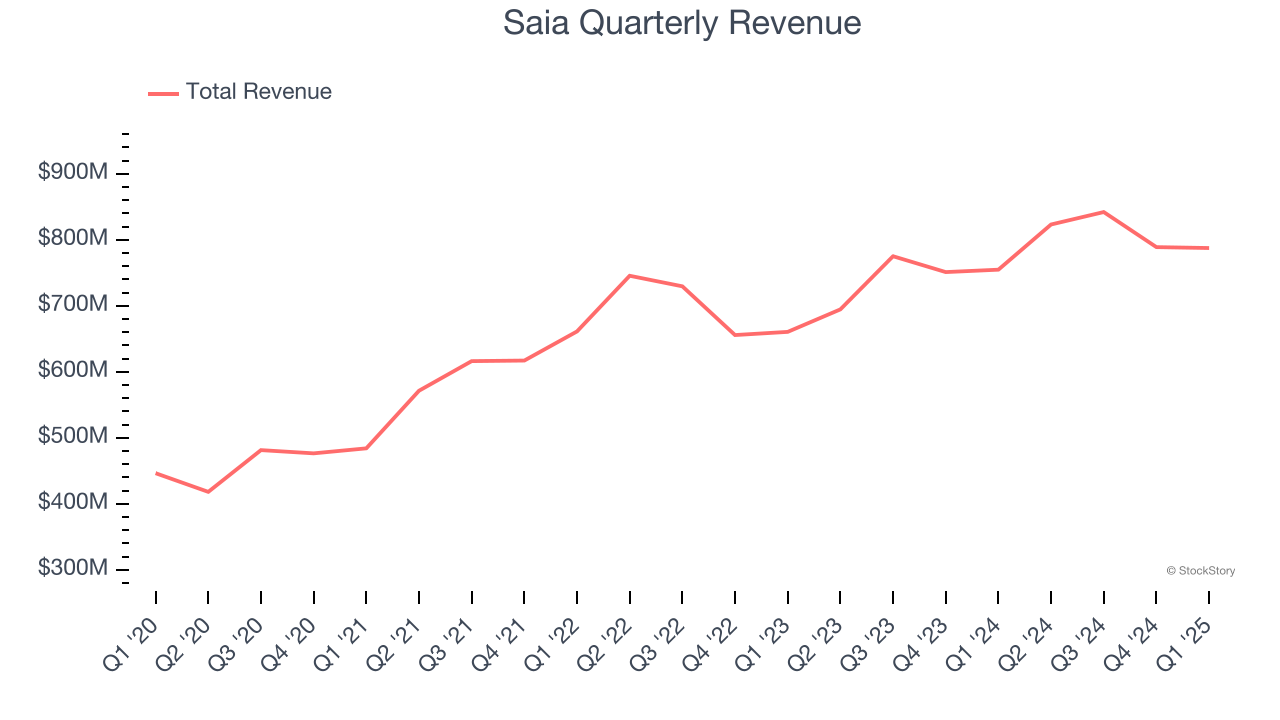
Long-term growth is the most important, but within industrials, a half-decade historical view may miss new industry trends or demand cycles. Saia’s annualized revenue growth of 7.8% over the last two years is below its five-year trend, but we still think the results were respectable. We also think Saia’s recent performance stands out as many other Ground Transportation businesses have faced declining sales because of cyclical headwinds. 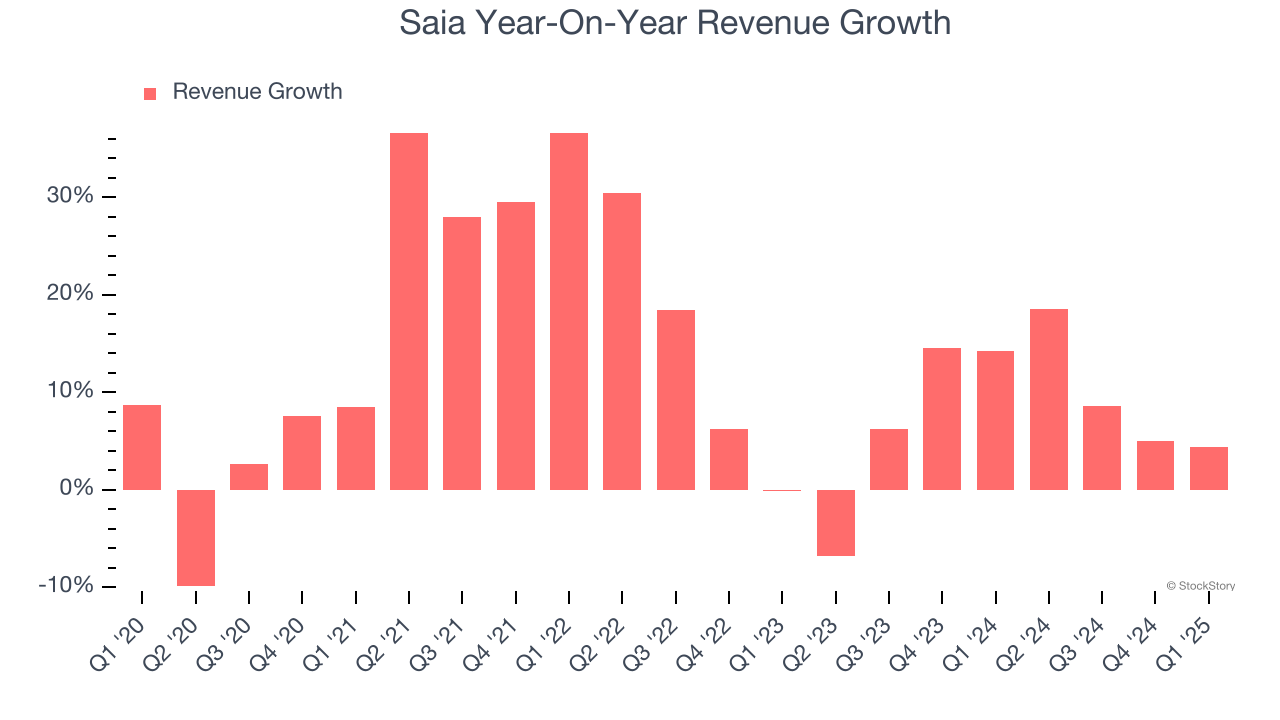
We can better understand the company’s revenue dynamics by analyzing its number of tons shipped, which reached 1.55 million in the latest quarter. Over the last two years, Saia’s tons shipped averaged 7.2% year-on-year growth. Because this number is in line with its revenue growth, we can see the company kept its prices fairly consistent. 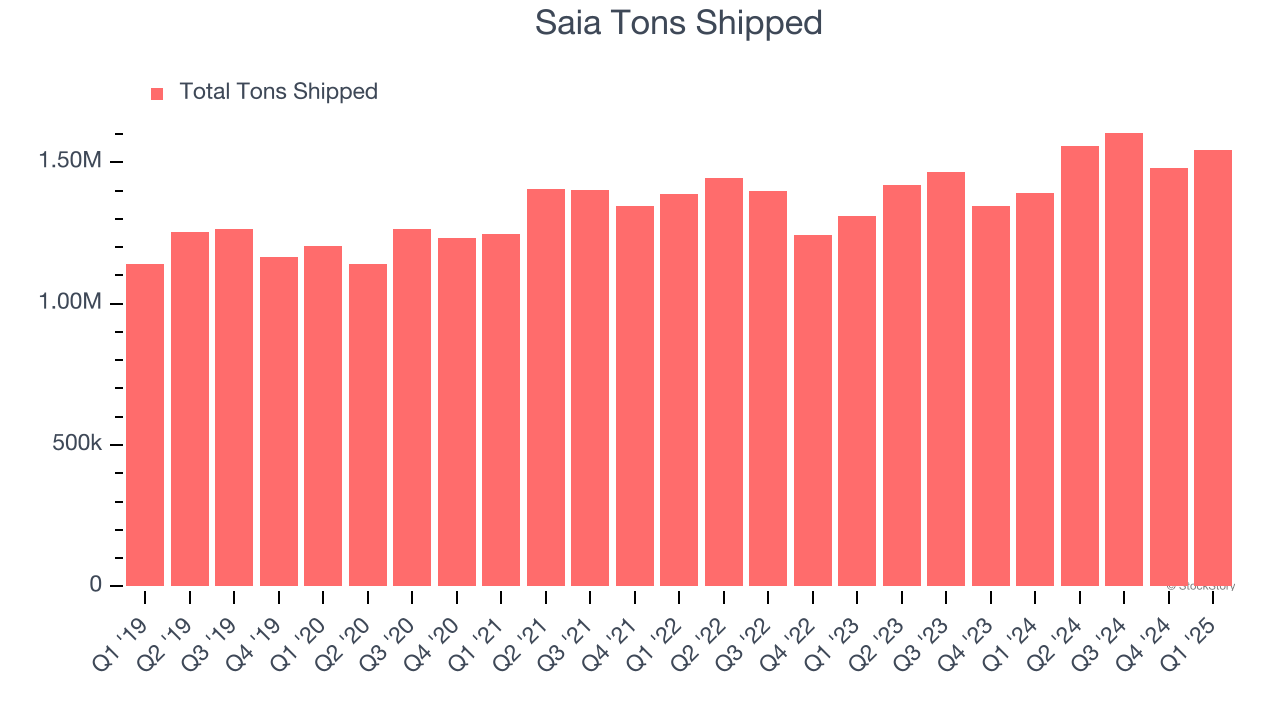
This quarter, Saia’s revenue grew by 4.3% year on year to $787.6 million, falling short of Wall Street’s estimates.
Looking ahead, sell-side analysts expect revenue to grow 8.5% over the next 12 months, similar to its two-year rate. This projection is above the sector average and suggests its newer products and services will help support its recent top-line performance.
Software is eating the world and there is virtually no industry left that has been untouched by it. That drives increasing demand for tools helping software developers do their jobs, whether it be monitoring critical cloud infrastructure, integrating audio and video functionality, or ensuring smooth content streaming. Click here to access a free report on our 3 favorite stocks to play this generational megatrend.
Operating Margin
Operating margin is an important measure of profitability as it shows the portion of revenue left after accounting for all core expenses – everything from the cost of goods sold to advertising and wages. It’s also useful for comparing profitability across companies with different levels of debt and tax rates because it excludes interest and taxes.
Saia has been an efficient company over the last five years. It was one of the more profitable businesses in the industrials sector, boasting an average operating margin of 14.7%. This result was particularly impressive because of its low gross margin, which is mostly a factor of what it sells and takes huge shifts to move meaningfully. Companies have more control over their operating margins, and it’s a show of well-managed operations if they’re high when gross margins are low.
Analyzing the trend in its profitability, Saia’s operating margin rose by 3.2 percentage points over the last five years, as its sales growth gave it operating leverage.
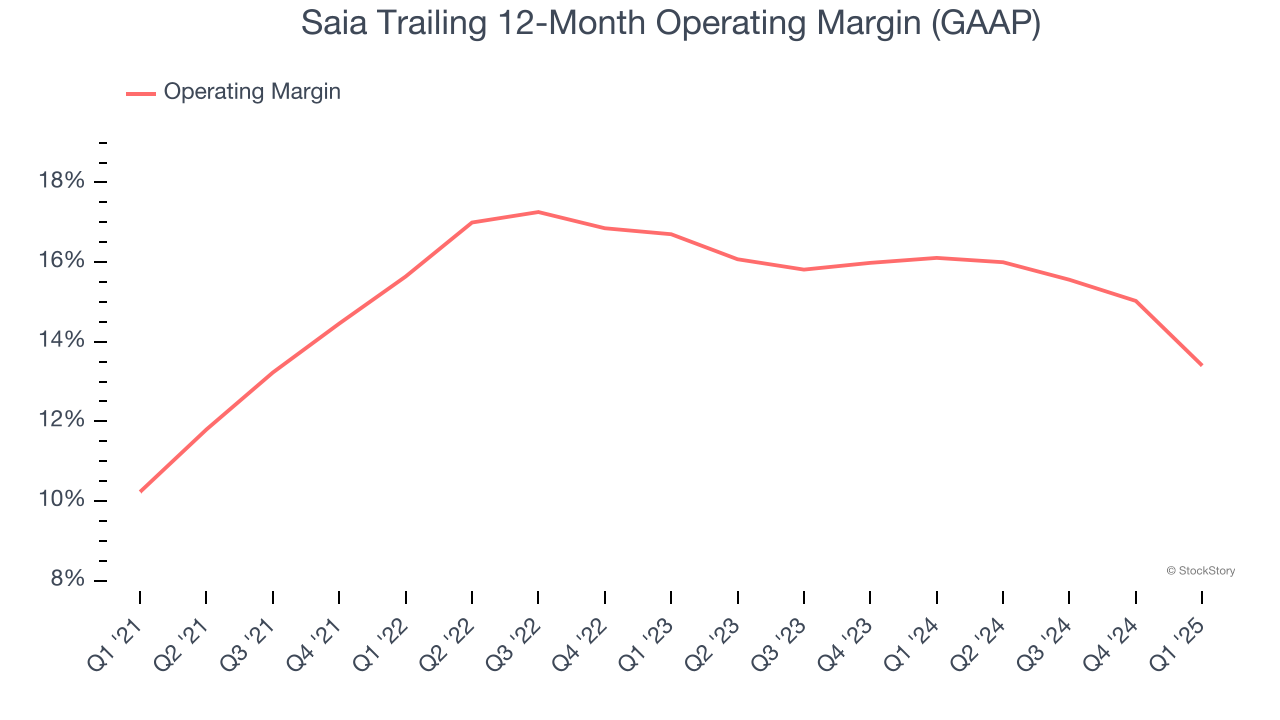
In Q1, Saia generated an operating profit margin of 8.9%, down 6.7 percentage points year on year. Since Saia’s operating margin decreased more than its gross margin, we can assume it was less efficient because expenses such as marketing, R&D, and administrative overhead increased.
Earnings Per Share
Revenue trends explain a company’s historical growth, but the long-term change in earnings per share (EPS) points to the profitability of that growth – for example, a company could inflate its sales through excessive spending on advertising and promotions.
Saia’s EPS grew at an astounding 21.5% compounded annual growth rate over the last five years, higher than its 12.2% annualized revenue growth. This tells us the company became more profitable on a per-share basis as it expanded.
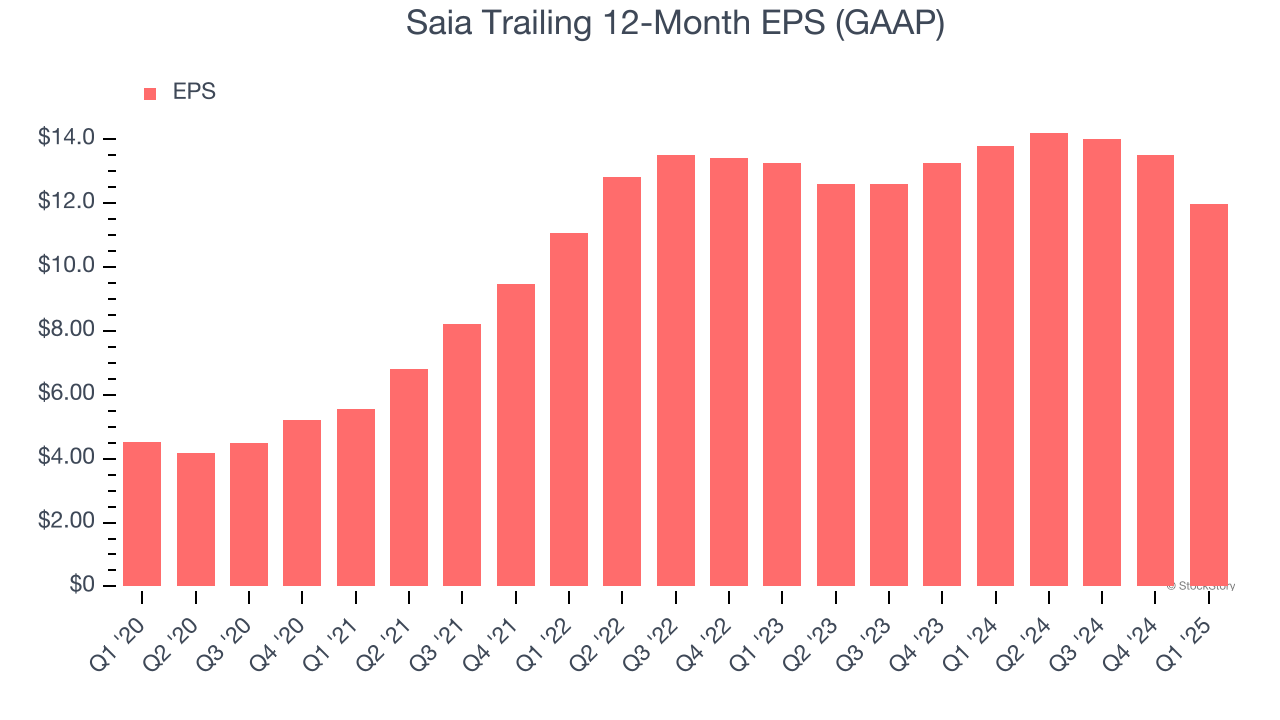
Diving into the nuances of Saia’s earnings can give us a better understanding of its performance. As we mentioned earlier, Saia’s operating margin declined this quarter but expanded by 3.2 percentage points over the last five years. This was the most relevant factor (aside from the revenue impact) behind its higher earnings; taxes and interest expenses can also affect EPS but don’t tell us as much about a company’s fundamentals.
Like with revenue, we analyze EPS over a more recent period because it can provide insight into an emerging theme or development for the business.
For Saia, its two-year annual EPS declines of 5% mark a reversal from its (seemingly) healthy five-year trend. We hope Saia can return to earnings growth in the future.
In Q1, Saia reported EPS at $1.86, down from $3.38 in the same quarter last year. This print missed analysts’ estimates, but we care more about long-term EPS growth than short-term movements. Over the next 12 months, Wall Street expects Saia’s full-year EPS of $11.99 to grow 28.4%.
Key Takeaways from Saia’s Q1 Results
We struggled to find many positives in these results. Its revenue missed significantly and its EBITDA fell short of Wall Street’s estimates. Overall, this was a weaker quarter. The stock traded down 10.8% to $315 immediately following the results.
Saia’s earnings report left more to be desired. Let’s look forward to see if this quarter has created an opportunity to buy the stock. The latest quarter does matter, but not nearly as much as longer-term fundamentals and valuation, when deciding if the stock is a buy. We cover that in our actionable full research report which you can read here, it’s free.
